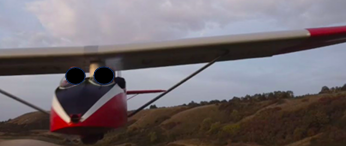Lessons Learned: Slingsby Glider Mid-air Collision

AAIB (Air Accidents Investigations Branch) investigated the mid-air collision of a Slingsby glider (WB 924) with an unmanned aircraft.
During the approach to Dunstable Airfield, Bedfordshire, the Slingsby glider was struck by a small, unmanned aircraft (UA) that from the memory card recovered from the UA showed that it was intentionally flown close to the glider.
The Slingsby glider sustained superficial damage to the surface of the wing.
History of the flight
On the approach to land at Dunstable Airfield, at approximately 100 ft agl, the pilot and passenger in WB 924 saw a small UA which several seconds later passed close to the head of the passenger and struck the leading edge of the left wing. The glider landed safely, and the damage was later assessed as “cosmetic.” The glider pilot reported that the UA was flown from a ridge, east of the airfield.
The UA fell to the ground and was retrieved by two young individuals who shared the UA log and video footage with a witness. The log and video show that the UA was flown on the direct approach path of the glider, and the glider was in view of the camera on the UA. Figure 1 is an image taken from the UA video just prior to impact. The video also shows that the UA was being flown from a public car park locate
Operation of unmanned aircraft
UA involved in the accident
From a photograph of the UA, taken by a witness after the accident, it was identified as a DJI Mini 2, which is equipped with a camera and weighs 249 g. The images supplied to the AAIB did not display an Operator ID, nor was an ID reported to the AAIB.
Regulations and guidance
WB 924 A UA is classified as an aircraft and the Air Navigation Order Article 241 states: AAIB-29662 “A person must not recklessly or negligently cause or permit an aircraft to endanger any person property.” The Regulations for the operation of UAs are in UK Regulation (EU) 2019/947. The CAA have published guidance material in The Drone Code1.
The Code states that for a UA below a weight of 250 g, and equipped with a camera, an Operator ID is required, which must be labeled on the UA. Operators must be 18 years or over to obtain an Operator ID. Younger pilots can still fly the UA under the supervision of their guardian or parent, providing they register for an Operator ID.
Conclusion
The midair collision occurred because the UA was intentionally flown on the approach path of the glider. Operation of the UA required an Operator ID, but the pilots were both too young to obtain one.
Read the full AAIB report: “AAIB investigation to Slingsby T.21B, WB 924.”



